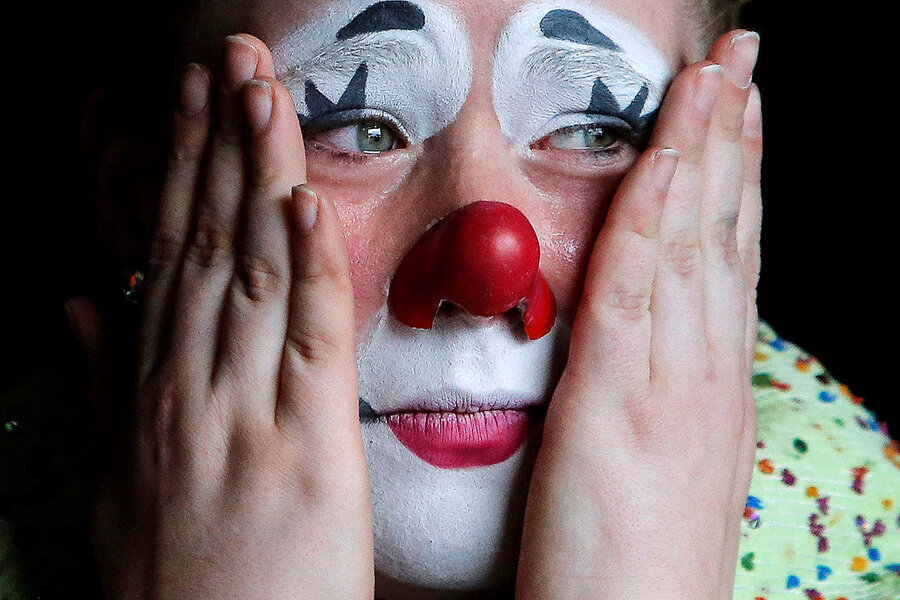Last show for Ringling: Why it’s not really the end of the circus
Loading...
| WORCESTER, MASS.
It’s the end of an era. Or is it?
On May 21 the circus long promoted as “The Greatest Show on Earth” is closing down with a final performance in Uniondale, N.Y. – attended by no small dose of bittersweet nostalgia from fans and the media.
Richard Bukowski can tell you. He and his wife attended the Ringling Bros. and Barnum & Bailey Circus as kids – half a century before attending a recent show by the same circus in Worcester, Mass.
“Oh, I remember they used to have those side shows,” Mr. Bukowski says, his mind recovering childhood memories such as seeing a sword eater.
To many, the demise of Ringling – a circus that defined the word for a century and half – seems unfathomable. Yet the real story here is less the death of the circus than its evolution. True, old standbys such as exotic animals or “freak” human performers have fallen out of favor. But the age-old yearning for dazzlement and virtuosity is alive and well. And although those desires are increasingly being met by other forms of entertainment, circuses remain part of the act.
“So many times in history there’s been the death knell of the circus conversation,” says Scott O’Donnell, executive director of Circus World, a museum and performing circus in Baraboo, Wis. “When they stopped traveling from town to town on horse-drawn wagons and they moved to this new form of transportation called trains – oh my goodness, that was the end of the circus as we know it.”
Yet it wasn’t. The circus survived many other challenges along the way. Ringling’s exit signals how rising public concern for animal rights has altered the business, but there is strong evidence that the circus arts continue to flourish even without animals.
Mr. O’Donnell , a former Ringling clown, estimates that at least 50 circus companies operate in the United States. Youth circuses are also a burgeoning phenomenon. And Montreal-based Cirque du Soleil, which recognized a cultural shift 30 years ago when it dared to launch a modernized circus without animals, has become one of the largest entertainment companies in the world. It produces shows not only under the traditional, big-top tent, but also in theaters on Broadway and in Las Vegas.
Circuses just have a lot more competition than they used to – in part from the proliferation of digital media.
“When the circus came to town, it was like the antecedent to the internet,” says Preston Scott, organizer of the Smithsonian Folklife Festival which this summer – coincidentally – will feature the circus arts on the National Mall in Washington, D.C.
“It’s where you saw colors, shapes, forms, heard languages, tasted foods, smelled things, saw animals,” Mr. Scott says.
As those experiences became more widely available, the circus’s role in society evolved, and its endurance was challenged.
Ringling did not keep up. In January, Kenneth Feld, the chief executive of Feld Entertainment, which owns Ringling, announced that the show would not go on, citing high operating costs and declining ticket sales after the company succumbed to public pressure in 2016 to retire its elephants.
Meanwhile, other American circus performances in recent decades have been evolving away from spectacles centered around exotic animals and toward the theatrical style of European circuses. Even in America, circuses have their roots in small troupes that featured equestrians, tightrope walkers, acrobats, and clowns, says Janet M. Davis, a history professor at the University of Texas in Austin and author of the 2002 book, “The Circus Age: Culture and Society under the American Big Top.”
“The future of circus in America is really in the direction of these more intimate experiences: one-ring shows focused on individual performances instead of on the entirety of spectacle,” Dr. Davis says.
Among the many varieties today are shows such as Quixotic based in Kansas City, Mo. It features ethereal acrobatic performances illuminated by electrifying light shows and accompanied by ambient, electronic music. The Australian-based Circus 1903, which is touring the US for the first time this year, is a revival of a turn-of-the-century circus, complete with elephants – though theirs are giant puppets.
The circus also is attracting more young people, and not the traditional, circus-family children, but outsiders. Youth circuses, including schools and troupes, have proliferated to 250 across the country, most of those founded only in the past couple of decades. Circus supporters hope more newcomers will keep the art form fresh and popular for many more generations.
“When you get more people involved, creativity flourishes,” says Scott of the Smithsonian.
Back in 1793 Philadelphia, British equestrian John Bill Ricketts launched the circus in America as he performed tricks on horseback in front of an American audience that included George Washington. It was about a century later, in 1884, that five Ringling Brothers (out of seven total) from the Wisconsin town of Baraboo launched their circus.
Today, troupes are busy defining what it will mean to be a circus in the 21st century. And now, with Ringling’s shadow lifted, these shows could attract more attention, says Scott.
“It’s almost like ... a big tree with all of its bark falling off and then there’s this sliver of life that’s really vibrant and growing quickly underneath all that crust,” he says.






